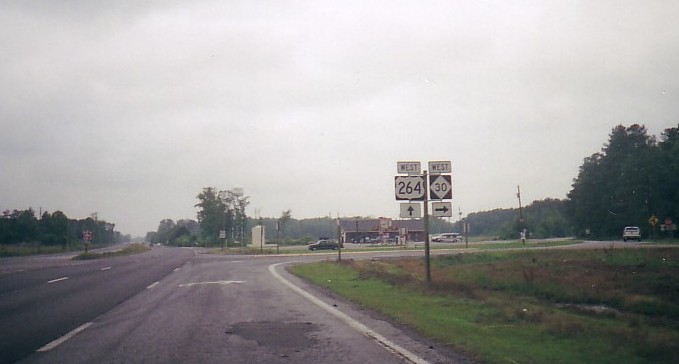| N.C.
30 15 miles |
|
|
|
|
| The Road: |
|
Begins at US 264 near Pactolus and ends at US 13/NC 11 below Bethel, all within Pitt County.
|
Towns and Attractions: |
|
Pitt Co.: Stokes
|
History: |
|
NC 30 was born in 1975 or 1976 as a renumbering of a piece of NC 33, running as it does now. This was part of a swap that included the previous NC 30, which was born about 1948 as new routing, running from NC 33 (the US 264-NC 30 jct) west to NC 11 (now just Greene St) Greenville.
In 1958, NC 30 was extended west slightly to current US 13-NC 11/903. When the 1975-76 swap occurred, NC 30 became mostly US 264 but inside the Greenville Bypass it became part of NC 33.
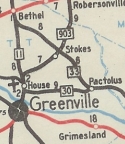
NC 30 #2's routing
|
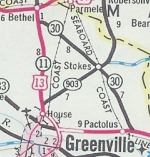
Today's NC 30 appears
|
The first NC 30 was an original state highway. It began at the original NC 20 in Wilmington (Market St. at 17th today) and proceeded northeast along modern US 17 to Jacksonville. From Jacksonville, NC 30 used Hargett St and Country Club Rd to Piney Green Rd which it followed east to White Oak. NC 30 then followed "Old 30 Rd" northeast to Morton Fork, then Belgrade-Swansboro Rd north back to today's US 17.
NC 30 followed modern 17 to Pollocksville and the Craven County Line before using Old Pollocksville Rd through the River Bend area. After a brief return to US 17, NC 30 used Trent Blvd into New Bern becoming Pollock St. Initially it appears NC 30 followed this to the Neuse River but later maps suggest a jaunt north on then-NC 10 (George St) to Broad St then east to the River.
NC 30 followed nearly none of modern US 17 from Bridgeton to Vanceboro, using Old Vanceboro Rd (2 segments); Forest Rd; Old Brick Rd. The 1930 Craven County map clearly shows NC 30 using these old alignments. NC 30 used most of 17 Business through Vanceboro, then Old Washington Rd to nearly Beaufort County. At today's NC 102, NC 30 used Old New Bern Rd, then modern 17 to Chocowinity.
Approaching the Tar River, it used an alignment still visible and partly abandoned west of the modern route to Wichard's Beach Rd.
The 1936 County Maps show that the modern US 17 existed everywhere here, so NC 30 may have briefly been placed on this alignment before removal.
NC 30 used today's US 17 through Washington (used Bridge, 5th, and Hackney Ave) to Windsor, except it used US 17 Business through Williamston. At Windsor, NC 30 followed US 13 Business, then US 13 and NC 305 to Aulander. NC 30 picked up NC 11 Business, then NC 42 to Ahoskie
NC 30 followed US 13, then NC 461 into Winton. NC 30 crossed the Chowan River on Main St, then picked up US 158 which it followed to Sunbury except it used US 158 Bus to Gatesville. From Sunbury NC 30 followed today's NC 32 north to Virginia at Corapeake. Virginia didn't number its side until 1923 (as VA 103).
The first discernible change to NC 30 occurred by 1924, where NC 30 was given the modern US 17 routing from Jacksonville to Maysville. The initial routing became secondary in 1924 although Piney Green Rd was part of NC 24 a little later.

NC 30 from Jacksonville to Belgrade, indirectly
|
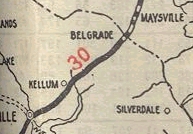
NC 30 direct transit
|
In 1927, US 17 was assigned to NC 30 from Wilmington to Windsor
In 1929, NC 30 south was extended with US 17/NC 20 along Market St, then north on 3rd St (was part of NC 40) to Nixon/Parsley. NC 30 crossed the NE Cape Fear river on Parsley, and then cut south down to modern US 76, then used old US 17 through Belville. NC 30 then left US 17/NC 20 and replaced NC 201 southwest to Supply, then continued as new routing to the South Carolina line near Little River, SC. This was essentially modern US 17 and 17 Businesses through Bolivia and Shalotte.
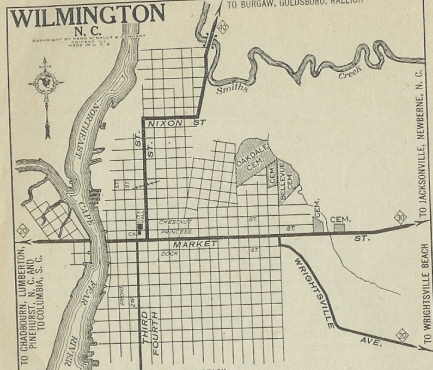
NC 30 Wilmington (1921-28)
|
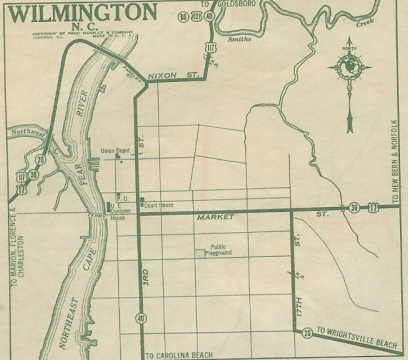
NC 30 Wilmington (1929-34)
|
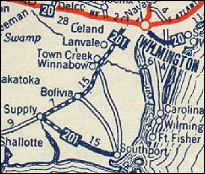
NC 201 south of Wilmington
|
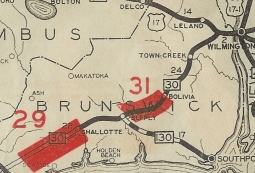
NC 30 extended to South Carolina
|
In 1932, US 117 was assigned to all of NC 30 south of Wilmington (US 17 was still heading west to Whiteville).
In late 1934, NC 30 south was truncated to end at US 17 (current US 13 Bus-US 17 Bus split) in Windsor. US 17 remained from Windsor to Wilmington and US 117 remained from Wilmington to South Carolina.
Also in late 1934, NC 30 from Sunbury to Virginia became part of NC 32 and instead was sent east to Elizabeth City and ended at NC 34 (now NC 168) Sligo. This was a replacement of a lot of NC 34.
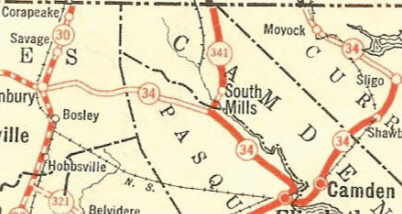
NC 34, Sunbury to Sligo
|
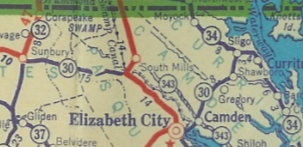
NC 30, Sunbury to Sligo
|
In 1940, NC 30 was rerouted at Winton to replace NC 35 over to US 158 Murfreesboro. The old NC 30 became NC 97 from Winton to Windsor.
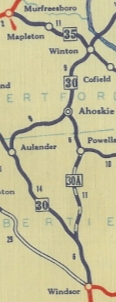
NC 30, Windsor to Winton
|
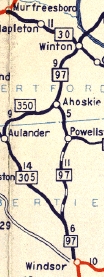
NC 97, Windsor to Winton; NC 30 to Murfreesboro
|
Also in 1940, NC 30 was rerouted at Camden to continue east to end at NC 34 (current US 158/NC 168 jct) Barco. Camden to Sligo became part of NC 170 (now is NC 34).
In 1941, NC 30 was finally killed when it was replaced in its entirety by a rerouted US 158, which it remains today except for the US 158 Business routes and Morgans Corner to Elizabeth City is mostly Northside Dr and US 17 Bus.

NC 30, Murfreesboro to Barco

US 158 replaces NC 30
|
Comments: |
|
NC 30 has little traffic as it doesn't provide a useful corridor for many.
Official maps imply NC 30's north end is at the same place as the US 13-NC 11 Business south end from Bethel but that is NOT the case.
The Brick Rd alignments of original NC 30 were indeed paved with brick, some of which was still present in the 1990's. I haven't been there in a good long while to see if any segments survive today.
|

